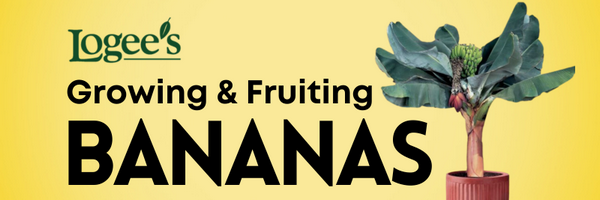Banana Tree Plants for Sale - How to Grow and Care for Musa Banana

Banana trees, belonging to the Musa genus, are tropical plants known for their iconic fruit and large, lush leaves. These popular plants make an excellent choice for gardeners seeking a dramatic focal point or a touch of the tropics. Though not true trees, their pseudostems can reach heights of 10-20’ tall, depending on the variety. Whether your banana plant is a dwarf banana, a tall banana, a red banana or a variegated banana, in the genus Musa the basic cultural needs are the same. And growing your own bananas is an exciting and rewarding process, especially when you harvest your first delicious homegrown fruit! First, we'll share five featured banana tree plants for sale at Logee's that we think you'll love, followed by important banana plant care information:
Featured Banana Tree Plants
Banana Plant ‘Dwarf Lady Finger’ (Musa acuminata)
Yes, you can grow and harvest delicious bananas in a pot! This new banana grows up to be 5' high, which is about as good as it gets in the world of dwarf bananas. We were surprised at how early this cultivar came into fruit, outpacing any of the other container-sized bananas we've grown. The trunk and leaves are modest in size, making Dwarf Lady Finger manageable for indoor and patio culture. The fruiting flower stem displays itself beautifully, arching and pendulating from the plant's crown.
Banana Plant ‘Super Dwarf Cavendish’ (Musa acuminata)
Anyone can grow bananas at home! This exciting strain of the Cavendish banana will actually produce fruit at a manageable height of just 3’ or less, and the bananas will appear often after one year. Although the fruit is smaller than commercial bananas, they're perfect for little hands or small appetites. 'Super Dwarf Cavendish' is an amazingly fast-growing, easy-care banana plant.
Banana Plant ‘Veinte Cohol’ (Musa hybrid)
Rare and hard to find, Musa ‘Veinte Cohol’ is a fast fruiting banana plant. Specimens going into summer measuring 2-3’ tall will often flower and fruit by summer’s end, providing you with bumper crop of bananas. ‘Veinte Cohol’ can be grown successfully in large containers in the north or planted in the ground in zones 9-10. Reaching 6-8’ tall, the plant flowers quickly the second season and the fruit forms over the summer. The 4-6” sweet, tasty bananas have an unusual shape, pointed at both ends and rounded in the middle like an elongated egg with points. This variety will produce 30-35 pounds of bananas per bunch.
Banana Plant ‘Double Mahoi’ (Musa hybrid)
If you’re looking for maximum fruit production, ‘Double Mahoi’ is for you. This unusual banana produces two large heads of fruit in its second cycle of fruiting. This banana plant plant is very productive, and the sweet bananas are dessert quality. ‘Double Mahoi’ is a mutation of Musa Dwarf Cavendish, so they have similar growth requirements. It starts fruiting at 5-6’ tall and makes an excellent container plant.
Hardy Banana Plant (Musa basjoo)
Imagine growing tropical bananas in your outdoor garden as far north as New England! Hardy Banana Plant has a defining tropical look and can survive temperatures below zero with mulching. This vigorous banana grows several feet in a season, forming large clumps up to 13' tall. Also called the Japanese Fiber Banana, it thrives in containers and indoor environments with varying temperature and light conditions. Though it produces inedible bananas, it's easy to grow with ample water, fertilizer, and sunlight.
Banana Plant Care
Bananas can be classified into two groups: the ornamental variety is grown for its foliage and flowers, and the fruiting variety is grown for its edible fruit as well as its tropical foliage. Varieties range from a few feet to up to 20' tall and the flowering cycle is also variety dependent. The variety 'Viente Cohol' is one of the fastest fruiting varieties or short cycle bananas that can fruit within a year, even in the north. In contrast, the 'Dwarf Red' can take three or more years to fruit under the same conditions in northern growing conditions.
Banana Plant Structure
Bananas are really bulbs, much like a daffodil. The vegetative part is made up of leaf petioles tightly stacked together to form a trunk or pseudostem. Like all flowering bulbs, the bud itself is under the soil and as the cycle of flowering approaches the bud emerges from the bulb or the base of the plant and rises up through the trunk or pseudostem to emerge at the top and create a flower or inflorescence and in time bananas.
The Secret to Flowering or Fruiting a Banana Plant
When you grow bananas for fruit, the environment has to be ideal many months before the bud is visible; therefore, a young plant must have ideal conditions for successful flowering and fruiting. Also, pay attention to the variety of banana, as some banana plants can more easily tolerate conditions that are less than optimal.
Optimal Conditions for Banana Plants
There are four important considerations in order for your banana plant to thrive and be happy. Banana plants require:
1. Full Sun
2. Warm Temperatures
3. Regular Watering
4. Frequent Fertilization
In the optimum environment, when all four of the above ingredients are given in abundance, the banana plant will thrive and reward the gardener with lush growth and fruit. However, if any of these ingredients are missing, the banana will still grow just at a slower rate. Most bananas can take lower light and cooler temperatures as well as reduced fertilizer without stopping the flowering process; it just slows it down and can reduce the amount of bananas produced.
How to Grow Bananas in Containers
Container grown bananas can be wintered over in a sunroom, an above freezing garage or cellar. Banana plants grown in a garden can be dug and lifted out of the ground before winter and stored in an above freezing area. The plant will have yellow leaves but the trunk and some of the roots will be alive waiting for the next growing season. This is one way to grow bananas in the north. This method also helps to contain their size so they are manageable.
Factors for Flowering and Fruiting
Getting bananas to flower and fruit does take time depending on location. In tropical areas, it often takes a year or more for the young shoot to develop into a tree and produce fruit. In the north, that same banan plant could take 2-3 years due to the disruption of winter with shorter day length and cooler temperatures. Once the flower and fruiting stalk appears, allow the green bananas to fully develop and fill out. This usually takes 3-4 months. Then the entire fruiting stalk is cut off the plant and may be hung upside down in a cool, shady location to fully ripen and turn yellow. Bananas ripen quickly, usually within a week or two at the most.
Should You Remove Banana Plant Offshoots?
Another characteristic is the production of offshoots from the main bulb. This is one way that bananas reproduce, and the gardener can take advantage of this for propagation. When a banana goes through the flowering and fruiting cycle, the main plant will die and it's the offshoots take over, starting another new plant.
Generally, the old trunk is cut off and the plants can be divided if more are desired. As a rule of thumb for bananas grown in the ground, three offshoots are allowed to grow once the main trunk is removed. Remember it is important to give the young plants plenty of light, water and fertilizer so the flowering and fruiting potential will be maximized. Developing offshoots that are growing in low light and are given little fertilizer, generally won't reach their full yielding potential when in fruit or flower. For bananas grown in pots, this is often seen with fewer bananas on the flower stem.
Temperatures and Fertilizer
When temperatures are warm and bananas are in their active growth stages, they are heavy feeders requiring a nutrient rich soil. This can be accomplished in pots by adding small amounts of a soluble fertilizer to the water or topdressing with a slow release or granular fertilizer. Any balanced fertilizer where the NPK numbers are close to even will work, but banana plants can be supplemented with additional potassium and magnesium for best growth and fruiting. When grown in the garden, the same is true with a feeding routine using a granular organic fertilizer sprinkled around the base of the plant several times during the summer. As with all plants, feeding can be over done, so it's better to apply smaller amounts more often.
How to Properly Water a Banana Plant
Water is also necessary in copious amounts as long as the soil or potting mix is well drained. In the garden with heavy clay soil or in high rainfall areas, less is needed but it is much like the watering done in any food-producing garden. Drought slows down the growth. When grown in pots in the summer, attention needs to be given daily to the plant's water needs. Many varieties are large growers and once they have filled out the largest container that the gardener can handle, then the fertilizer and watering requirements must be done with greater accuracy.
Ideal Pot Size for Banana Plants
Bananas come in many sizes from 3' to 20' tall and the size of the container needs to be proportioned to the final size of the banana. Depending on how big a pot you want to handle, bananas can be grown anywhere from a 5-gallon container to a 25-gallon container or even bigger. With regards to pot size, a smaller pot will restrict growth and this also means that the final fruit count will be smaller.
How to Measure and Manage Height
The height of a banana is measured from the soil up to where the leaves are emerging from the pseudostem. For example, a 5' banana would have a 5' trunk, plus the height of the leaves, which could be another 4'. For estimating height purposes, that 5' banana could grow to 9' tall at maturity.
When grown outside of their gardening zone, bananas can get very large during the summer and when brought inside there is often a problem of fitting them into their winter space. One option is to cut the pseudostem back to a manageable height. This removes the leaves as well as part of the trunk. As all the leaves are coming from the bulb in the soil, the plant will, in no time, replace the leaves and continue to grow, providing there is light and warmth. It also can shorten the height of the plant to some degree. The only down side to this procedure is that if the plant was in the midst of flowering and the flower stem was rising up through the center of the trunk, the fruit and flower would be lost. Generally, it best to do this on a plant that's a year old or less.
Banana Tree Plant Care - Summary
To ensure that your banana plants thrive and produce delicious bananas, proper care is essential. Start by planting them in well-draining soil with good organic matter. Provide regular watering, keeping the soil consistently moist but not waterlogged. Banana plants benefit from frequent fertilization with a balanced fertilizer, rich in potassium and phosphorus. Maintain a warm and sunny location for optimal growth. Mulching around the base of the plant helps retain moisture and suppress weeds. Remove any damaged or dead leaves to promote airflow and prevent disease. As the plant grows, provide sturdy support to prevent it from toppling over. With proper care, your banana plants will reward you with an abundance of tasty bananas!






